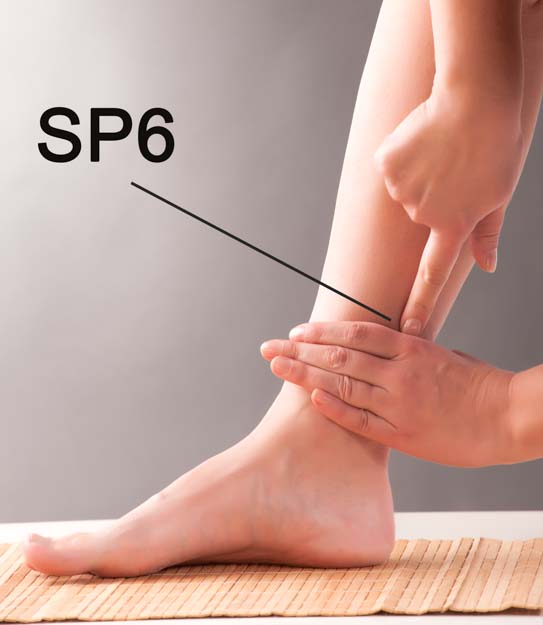Vitamin K3 injections into acupuncture point SP6 relieves menstrual cramping and pain. Researchers from institutions including Columbia University (New York), Stanford University School of Medicine (Palo Alto), and University of California at San Francisco (UCSF) completed a six year study of dysmenorrhea. The study design was rigorous: double-blind, double-dummy, randomized controlled trial. The researchers concluded, “Acupuncture point injection of vitamin K3 relieves menstrual pain rapidly and is a useful treatment in an urban outpatient clinic.” 
Primary dysmenorrhea affects approximately 85% of women and the pain is severe in approximately 20% of women experiencing menstrual pain. Although the pathophysiology is not identical in all cases, uterine prostaglandin hormones at high levels contribute to cramping and lower abdominal pain. The pain may last from several hours to days.
Acupuncture with injection therapy of herbal extracts has been used in China for over forty years. Prior research conducted in China and Italy indicates that acupuncture point injections of vitamin K3 is effective for the treatment of dysmenorrhea. The Menstrual Disorder Centre at the Obstetrics and Gynecology Hospital (Shanghai) has used acupuncture point injections of K3 since 1985.
Several groups received vitamin K3 injections to test acupuncture point injection efficacy. The active treatment group received injections of vitamin K3 bilaterally into acupoint SP6 (Sanyinjiao), located on the lower leg. A control group received saline injections into SP6. An additional control group received K3 injections into the right buttocks. Participants in the study met the inclusion criteria of: 14 – 25 years of age, severe primary dysmenorrhea for a minimum of 6 months, intractable pain not relieved or only partially relieved by any other treatment modality. Each participant received only one injection of K3. The active treatment group received one 4 ml injection per participant bilaterally into SP6 for a total dosage of 8 ml.
Participants receiving the injection into SP6 experienced rapid pain relief significantly greater than experienced by participants in the control groups. The researchers note that “acupuncture point injection with vitamin K3 in SP6 was found to be optimal, producing a greater clinical and statistically significant reduction in pain.” The add that K3 acupuncture point injection provided “rapid relief of severe as well as moderate pain” due to dysmenorrhea. Regarding integration into the medical system, the team notes, “Effective treatment can be administered in a high-volume hospital clinic and may be especially useful to women whose pain is unmitigated by other methods.” 
The research team notes that long-term relief up to six months is correlated to acupoint injections. In addition, Wang et al. measured a three month benefit of pain relief. The researches also indicated that acupoint injections are “perhaps quicker than NSAIDs” in providing pain relief.
The researchers note that the rigor of their investigation “extends the work of previous single-arm and cross-over studies through the implementation of a randomised parallel group design, and provides substantial evidence that the treatment provides pain relief for women with painful periods who have not been able to obtain satisfactory relief by any other method. Study results also indicate that the site of injection and the specific agent of vitamin K, specifically vitamin K3, are crucial to the optimal treatment of pain due to primary dysmenorrhoea.”
The findings are consistent with those of Chao et al. whose work at the University of California at San Francisco (UCSF) concludes that acupuncture point injections of vitamin K alleviate dysmenorrhea. The researchers injected vitamin K1 into acupuncture point SP6. The participants experienced less menstrual pain and a shorter duration of menstrual symptoms. The researchers note, “This finding is consistent with outcomes from the Obstetrics and Gynecology Hospital in Shanghai, China, where the protocol was developed.”
Acupoint SP6 is indicated for the treatment of dysmenorrhea according to Traditional Chinese Medicine (TCM) principles. Zhang et al. tested the ancient principle that tenderness at SP6 upon palpation is common for women experiencing dysmenorrhea. In a randomized investigation, the researchers note that “tenderness at Sanyinjiao (SP6) exists in women undergoing primary dysmenorrhea.”
References:
Wade C, Wang L, Zhao WJ, Cardini F, Kronenberg F, Gui SQ, Ying Z, Zhao NQ, Chao MT, Yu J. Acupuncture point injection treatment of primary dysmenorrhoea: a randomised, double blind, controlled study. BMJ open. 2016 Jan 1;6(1):e008166.
Zhao WJ, Weng JE, Yu J. Clinical study of vitamin K3 acupoint injection in treating pelvic pain. Chinese acupuncture & moxibustion 2000;20:393–4.
Wang L, Cardini F, Zhao W, et al. Vitamin K acupuncture point injection for severe primary dysmenorrhea: an international pilot study. Med Gen Med 2004;6:45.
Lesi G, Gramenzi A, Gammi L, et al. Vitamin K injection in San Yin Jiao acupoint (SP6) to treat severe primary dysmenorrhoea: results of a pilot study. Eur J Integr Med 2012;4:S51.
Chao, Maria T., M. L. Callens, C. M. Wade, P. D. Abercrombie, and D. Gomolak. "An innovative acupuncture treatment for primary dysmenorrhea: a randomized, crossover pilot study." Alternative therapies in health and medicine 20, no. 1 (2014): 49-56.
Zhang, C. N., X. K. Huang, Y. Luo, J. Jiang, L. Wan, and L. Wang. "Reflection of dysmenorrhea in acupoint sanyinjiao (SP 6) region." Zhen ci yan jiu= Acupuncture research/[Zhongguo yi xue ke xue yuan Yi xue qing bao yan jiu suo bian ji] 39, no. 5 (2014): 401.
Shi, Guang-Xia MSc, Liu, Cun-Zhi PhD; Zhu, Jiang BSc; Guan, Li-Ping MSc; Wang, De-Jin MSc; Wu, Meng-Meng MSc. Effects of Acupuncture at Sanyinjiao (SP6) on Prostaglandin Levels in Primary Dysmenorrhea Patients. Clinical Journal of Pain: March/April 2011 - Volume 27 - Issue 3 - p 258–261.


